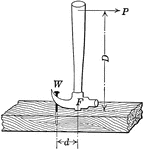Clipart tagged: ‘fulcrum’
Balance
"When bodies of equal weight are supported by the arms of a lever, they will balance each other when…
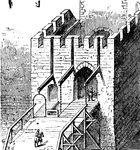
Draw Bridge
A bridge which may be drawn up or let down to admit or hinder communication, or to leave a transverse…

Crowbar
"... shows one of the commonest (sic) forms in which this kind of lever appears,-the crowbar. The power…

Cutting Pliers
Pliers are a hand tool used to hold objects firmly, or for cutting and bending tough materials such…

First Class Lever
"A lever is an inflexible bar freely movable about a fixed axis called the fulcrum. If the fulcrum is…

First Class Lever
"A Lever of the First Kind is one in which the fulcrum is between the power and the weight... where…
First Orders of Lever
In the first order of levers, the fulcrum is between the power and the weight.

Man with Lever and Fulcrum
"In mechanics, the point of rest about which a lever turns in lifting a body; also, a prop or support…

Gravity Train Remontoire
"E represents the scape-wheel turning in a minute, and e its pinion, which is driven by the wheel D…

Lever
"The object W to be lifted is called the weight; the force is represented by P; the point, or pivot,…

Lever
"The object W to be lifted is called the weight; the force is represented by P; the point, or pivot,…
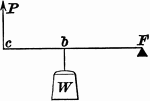
Lever
"The object W to be lifted is called the weight; the force is represented by P; the point, or pivot,…
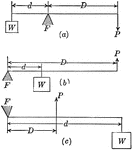
Lever and Fulcrum
Illustration of a lever with fulcrum F. W represents the weight lifted, P is the force that does the…
Lever Balanced on fulcrum With Weights
An illustration of a lever with weights m and n with distances a and b from fulcrum. Illustration could…

First Class Lever
"The lever of the first class has the fulcrum between the power and the weight." Examples: a common…

First Class of Lever: Fulcrum Between Power and Weight
This illustration shows the first class of lever. This class employs a fulcrum between the power and…

First Kind of Lever
"In straight levers of the first kind, the fulcrum is between the power and the resistance, as in fig…

Second Class Lever
"The lever of the second class has the weight between the power and the fulcrum." Examples: a nutcracker,…

Second Kind of Lever
"In the second order of levers, the resistance is between the fulcrum and the power; and, as before,…
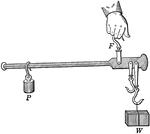
Steel-yard Used as a Lever
Illustration of an ordinary steel-yard being used as a lever. F represents the fulcrum. Weight P is…

Third Class Lever
"The lever of the third class has the power between the weight and the fulcrum." Examples: sewing machine…
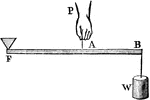
Third Kind of Lever
"In the third order of lever the power acts between the prop and the resistance, where also P : W ::…
Simple Machines
Images of different points about a fulcrum F. P is the power exerted on the object, W is the weight.
Bottle Opener
This is a corkscrew type bottle opener, or a device that enables the removal of metal bottle caps from…

Hydraulic Machine Exerting Pressure
Illustration of a hydraulic machine. "A principle known as Pascal's Law states that pressure exerted…
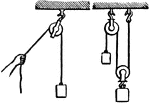
Pulley
"In the single fixed pulley (fig. 1) there is no mechanical advantage, the power and weight being equal.…

Pulley
"In a system of pulleys (figs. 3,4) in which the same string passes round any number of pulleys, and…

Pulley
"In a system in which each pulley hangs by a separate cord and the strings are parallel (fig. 5), there…

Scale
"A common scale-beam, used for weighing, is a lever, suspended at the centre of gravity, so that the…

Scissors
"Many instruments in common use are on the principle of this kind of lever. Scissors, consists of two…

Second Class Lever
"A lever is an inflexible bar freely movable about a fixed axis called the fulcrum. If the weight is…
Second-class Lever
"Two men carrying a load between them on a pole is also and example of this [second class] kind of lever.…

Second Class Lever
"A Lever of the Second Kind is one in which the weight is between the power and the fulcrum." —Quackenbos…

Second Order of Lever
In the second order of levers, the weight is between the power and the fulcrum.

Simple Lever
"Any rod, or bar, which is used in raising a weight, or surmounting a resistance, by being placed on…
Simple lever system
"Suppose that A is the lever, B the fulcrum, D the weight to be raised, and C the power. Let D by considered…
Simple Lever System
"Suppose the weight, B to be sixteen pounds and suppose the fulrum to be placed so near it, as to be…
Simple Lever System
"But let the fulcrum be moved along to the middle of the lever, with the weight of sixteen pounds still…

Spike Extractor
"An apparatus for extracting spikes, as from a rail. a, rail; b, spike to be extracted; c, fulcrum-piece…
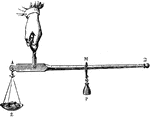
Steelyard
The steelyard is an instrument for weighing bodies by means of a single weight which can be hung at…

Shortnose Sturgeon Tail
"Heterocercal Caudal Fin of a Sturgeon (Acipenser brevirostris), showing the series of fulcrums, Fl,…

Third class lever
"A lever is an inflexible bar freely movable about a fixed axis called the fulcrum. If the power is…

Third-class Lever
"In the third and last kind of lever, the weight is placed at one end, the fulcrum at the other end…
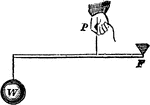
Third Class Lever
"A Lever of the Third Kind is one in which the power is between the weight and the fulcrum." —Quackenbos…
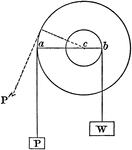
Wheel and Axle
"Considered as a lever, the fulcrum is at the common axis, while the arms of the lever are the radii…
